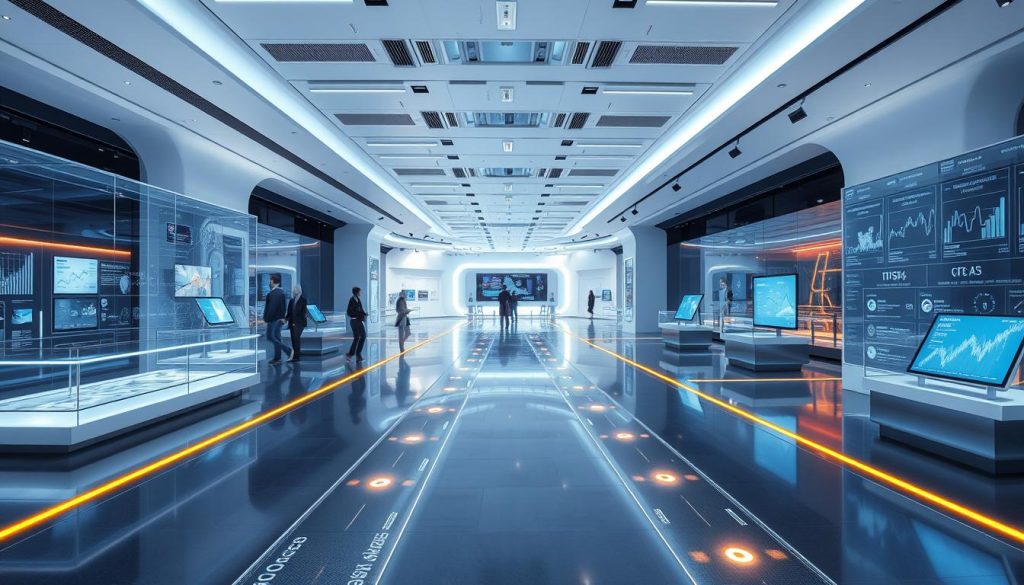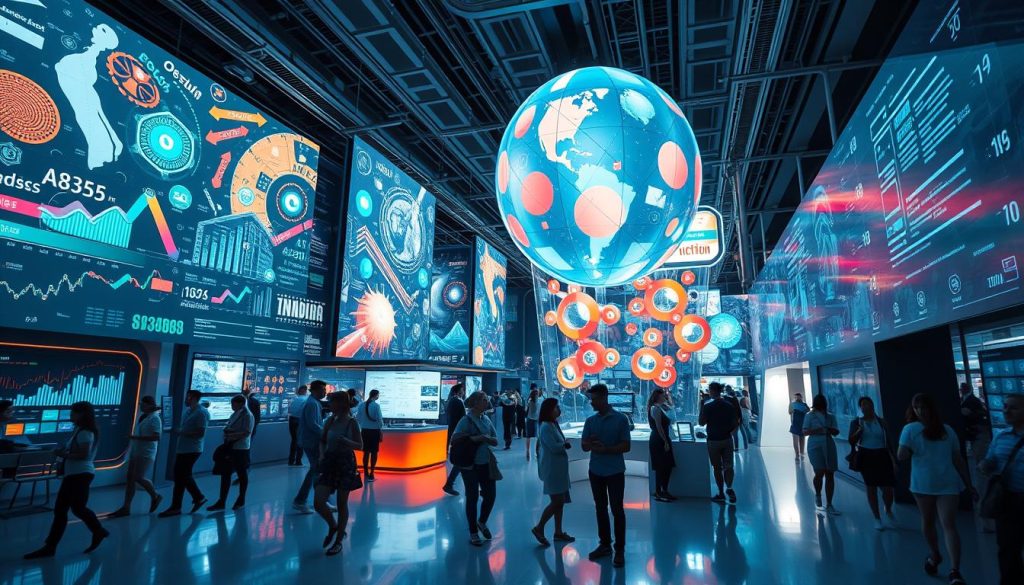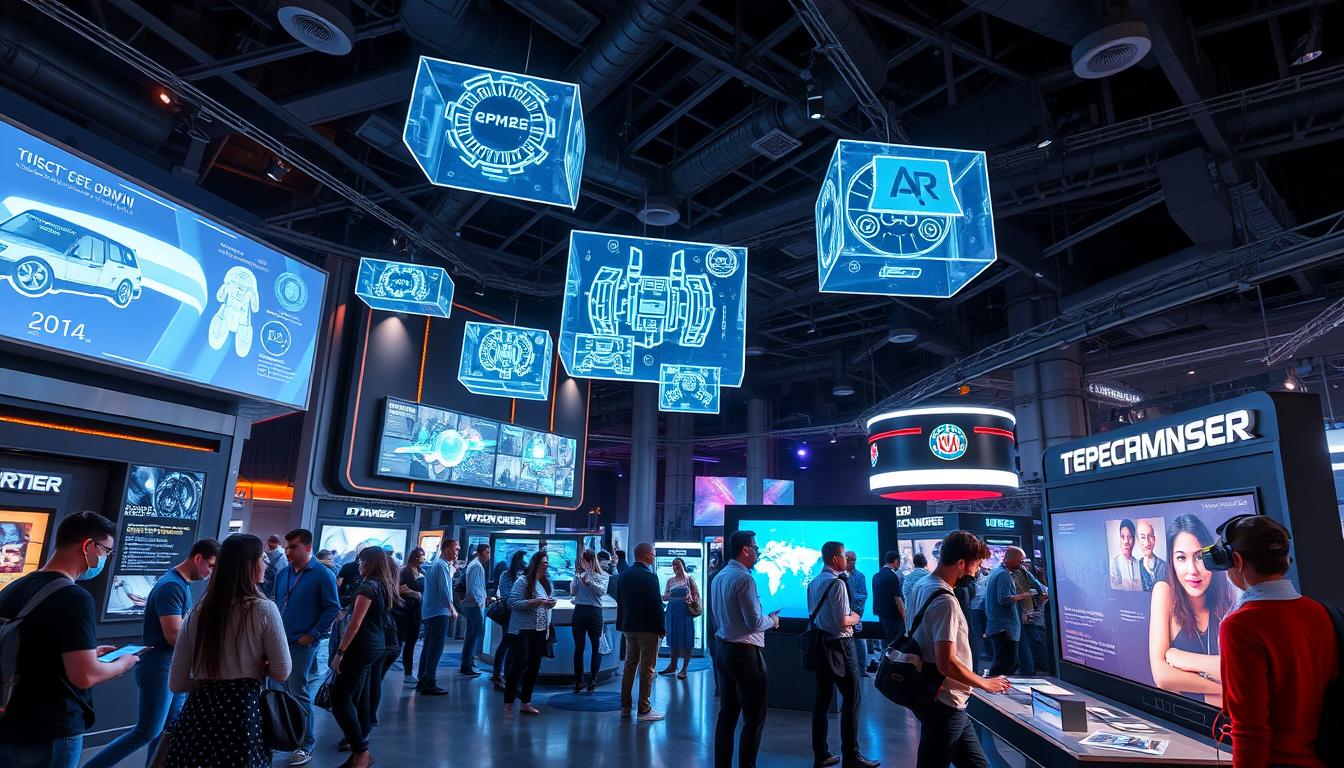The world of exhibitions is changing fast. Event automation and visitor engagement are now key to success. Smart exhibitions use tech to create amazing experiences. This shift is reshaping how we plan and run expos.
Gone are the days of static booths and one-size-fits-all approaches. Today’s expos are dynamic, interactive, and tailored to each visitor. Smart CRM tools help track interactions and boost engagement. They turn casual chats into solid leads.
By embracing these new tools, exhibitors can offer unique, memorable experiences. This leads to better ROI and happier visitors. It’s a win-win for everyone involved in the expo ecosystem.
Key Takeaways
- Event automation enhances visitor experiences
- Smart exhibitions use tech for personalized interactions
- Visitor engagement is crucial for expo success
- New tools help track and improve interactions
- Tailored experiences lead to better ROI
- Tech integration is key to future-proof expo strategies
The Evolution of Event Technology and Automation
Event technology has come a long way, revolutionizing the exhibition industry. From paper-based systems to cutting-edge digital solutions, the transformation has been remarkable. Today’s events leverage advanced technologies to create immersive experiences and gather valuable data.
Interactive experiences are at the forefront of this evolution. Touchscreen displays, mobile apps, and virtual reality stations engage attendees in ways never before possible. These technologies not only captivate audiences but also provide organizers with real-time feedback and analytics.
Data-driven insights have become crucial in shaping event strategies. By collecting and analyzing attendee behavior, organizers can tailor experiences to individual preferences. This personalization leads to higher engagement rates and more successful outcomes.
“The future of events lies in the seamless integration of technology and human interaction.”
Automation has streamlined many aspects of event management. From registration to follow-ups, automated systems handle tasks efficiently, allowing organizers to focus on creating memorable experiences. CRM management tools play a vital role in this automation, helping to nurture leads and maintain relationships long after the event concludes.
| Technology | Benefits | Adoption Rate |
|---|---|---|
| AI-powered Chatbots | 24/7 Attendee Support | 65% |
| RFID Badges | Seamless Check-in, Data Collection | 78% |
| Event Apps | Personalized Schedules, Networking | 92% |
As event technology continues to evolve, the possibilities for creating unforgettable experiences are endless. By embracing these innovations, event organizers can stay ahead of the curve and deliver exceptional value to both attendees and exhibitors alike.
Creating Seamless Interactive Experiences
Seamless interactive experiences are key to successful expos. They blend Immersive Marketing with Experiential Branding to create unforgettable moments. Let’s explore how to craft these engaging encounters.
Digital Touchpoints and Engagement Tools
Digital touchpoints are vital in modern expos. They include interactive kiosks, mobile apps, and social media integrations. These tools enhance visitor engagement and provide valuable data. For instance, QR codes can link to product demos or enable targeted marketing.
Personalized Visitor Journeys
Tailoring experiences to individual preferences is crucial. Use data from registration forms and past interactions to customize content. This approach mirrors the personalization used in email marketing for medical supply wholesalers, ensuring relevance and boosting engagement.
Real-time Interaction Management
Real-time management allows for dynamic adjustments during the event. It involves:
- Live chat support for immediate assistance
- Real-time polls and surveys for instant feedback
- Dynamic content updates based on visitor behavior
These Interactive Experiences create a responsive environment that adapts to visitor needs, enhancing overall satisfaction and brand connection.
Leveraging Data-Driven Insights for Better Engagement
Smart exhibitions thrive on data-driven insights. By harnessing the power of information, event organizers can create tailored experiences that resonate with attendees. Event technology plays a crucial role in collecting and analyzing visitor data, enabling organizers to make informed decisions and optimize engagement strategies.
One key aspect of leveraging data is understanding visitor behavior. By tracking attendee movements and interactions, organizers can identify popular exhibits, peak times, and areas that need improvement. This information helps in refining the layout and flow of future events, ensuring a smoother experience for all.
Personalization is another powerful tool in the data-driven arsenal. By analyzing past attendance records and maintaining clean contact lists, organizers can create targeted marketing campaigns that speak directly to individual interests. This approach not only boosts attendance but also enhances overall satisfaction.
Real-time data analysis during the event allows for on-the-spot adjustments. If certain areas are overcrowded or underutilized, staff can be reallocated or attractions modified to balance the experience. This agility is a hallmark of successful smart exhibitions.
“Data-driven insights are the compass guiding us to create unforgettable exhibition experiences.”
Post-event analysis is equally crucial. By examining attendee feedback, engagement metrics, and email campaign effectiveness, organizers can continually refine their approach. This iterative process ensures that each subsequent event builds upon the successes of the last, driving continuous improvement in the world of smart exhibitions.
Smart Exhibition Design and Layout Optimization
Smart Exhibitions are transforming the event industry with innovative design and layout strategies. By leveraging Event Automation and data-driven insights, organizers can create more engaging and efficient spaces for attendees.
Traffic Flow Analysis
Understanding visitor movement is crucial for optimizing exhibition layouts. Smart traffic flow analysis uses sensors and tracking technologies to map attendee paths, identifying bottlenecks and popular areas. This data helps organizers adjust layouts for smoother navigation and enhanced Interactive Experiences.

Heat Mapping Technologies
Heat mapping is a powerful tool for visualizing attendee behavior. By tracking dwell times and engagement levels, organizers can pinpoint hotspots and underutilized areas. This insight allows for strategic placement of exhibits, ensuring maximum visibility for key displays and sponsors.
Dynamic Space Utilization
Event Automation enables real-time adjustments to exhibition spaces. Flexible partitions and digital signage can adapt to changing crowd dynamics, creating a more responsive environment. This adaptive approach maximizes engagement opportunities and enhances the overall attendee experience.
| Optimization Technique | Benefits | Implementation Challenges |
|---|---|---|
| Traffic Flow Analysis | Improved navigation, reduced congestion | Privacy concerns, technology integration |
| Heat Mapping | Optimized exhibit placement, increased engagement | Data interpretation, real-time application |
| Dynamic Space Utilization | Adaptable environments, enhanced experiences | Cost of flexible infrastructure, staff training |
By embracing these Smart Exhibition techniques, event organizers can create more engaging and efficient spaces that cater to attendee needs and preferences, ultimately driving better outcomes for exhibitors and visitors alike.
Integrating Automated Marketing Solutions
Event Automation is revolutionizing the way we approach marketing for exhibitions and trade shows. By integrating automated solutions throughout the event lifecycle, organizers can boost Visitor Engagement and create Immersive Marketing experiences that leave lasting impressions.
Pre-event Communication Strategies
Effective pre-event communication sets the stage for success. Using platforms like Omnily.io can streamline your outreach efforts. Personalized email campaigns, social media scheduling, and targeted ads can generate buzz and attract the right audience to your event.
On-site Marketing Automation
During the event, automation takes center stage. Digital kiosks, mobile apps, and RFID technology enhance Visitor Engagement. These tools provide real-time updates, personalized recommendations, and seamless check-ins, creating a smooth and interactive experience for attendees.
Post-event Follow-up Systems
The event doesn’t end when doors close. Automated post-event follow-ups maintain momentum. Personalized thank-you emails, surveys, and content sharing keep the conversation going. This approach nurtures leads and turns one-time visitors into long-term customers.
| Stage | Automation Tool | Benefit |
|---|---|---|
| Pre-event | Email Campaigns | Increased Registrations |
| On-site | Mobile Apps | Enhanced Engagement |
| Post-event | Follow-up Systems | Improved Lead Conversion |
By leveraging these automated marketing solutions, event organizers can create a cohesive and engaging experience that spans the entire event lifecycle. This approach not only enhances Visitor Engagement but also maximizes ROI through efficient resource allocation and automated task management.
Measuring Success Through Analytics and Metrics
Data-Driven Insights are the backbone of successful Smart Exhibitions. Event Technology now offers powerful tools to measure and analyze every aspect of your expo. By tracking key performance indicators, you can fine-tune your strategies and boost engagement.

Attendance metrics are just the tip of the iceberg. Modern analytics delve deeper, revealing visitor behavior patterns and preferences. This wealth of information helps organizers create more targeted and effective experiences. GoHighLevel’s expert services can assist in optimizing these data-driven strategies.
Let’s explore some key metrics that drive success in Smart Exhibitions:
- Booth engagement rates
- Session attendance
- Lead quality scores
- Social media mentions
- Post-event survey responses
By analyzing these metrics, organizers can identify high-performing elements and areas for improvement. This continuous feedback loop ensures that each exhibition builds upon the success of the last, creating ever-more engaging and profitable events.
“In the world of Smart Exhibitions, data isn’t just numbers – it’s the key to unlocking unprecedented attendee experiences and exhibitor ROI.”
Event Technology platforms now offer real-time analytics dashboards. These tools allow organizers to make on-the-fly adjustments, optimizing the exhibition as it unfolds. Integrating tools like Omnily.io can further enhance your ability to track and respond to attendee behavior across digital touchpoints.
| Metric | Importance | Action Item |
|---|---|---|
| Booth Dwell Time | Indicates interest level | Optimize layout for flow |
| App Usage | Measures digital engagement | Enhance app features |
| Lead Conversion Rate | Shows ROI for exhibitors | Improve lead qualification |
Remember, the goal of these analytics isn’t just to collect data, but to turn those insights into actionable strategies. By leveraging these powerful tools, you can create Smart Exhibitions that truly resonate with your audience and deliver measurable results.
Building Immersive Brand Experiences
Immersive marketing is revolutionizing the way brands connect with audiences at expos. By creating interactive experiences, companies can leave lasting impressions on visitors. Let’s explore how cutting-edge technologies are shaping experiential branding.
Virtual Reality Integration
Virtual reality (VR) transports expo attendees into brand worlds. Companies use VR to showcase products, demonstrate services, or tell immersive stories. This technology allows visitors to explore virtual environments, creating unforgettable brand interactions.
Augmented Reality Applications
Augmented reality (AR) blends digital elements with the real world. Brands use AR to bring products to life, offer interactive demos, or create engaging games. This tech turns passive observers into active participants, enhancing the overall expo experience.
Interactive Display Technologies
Touch screens, motion sensors, and gesture-controlled displays are transforming static booths into dynamic spaces. These technologies enable visitors to interact with content, customize experiences, and engage with brands on a deeper level.
| Technology | Application | Benefit |
|---|---|---|
| Virtual Reality | Product Demonstrations | Immersive Experiences |
| Augmented Reality | Interactive Catalogs | Enhanced Visualization |
| Touch Screens | Custom Product Builders | Personalized Engagement |
By integrating these technologies, brands create memorable interactive experiences that resonate with expo visitors. This approach to experiential branding drives engagement and leaves a lasting impact on potential customers.
Future-Proofing Your Exhibition Strategy
Smart exhibitions are evolving rapidly, and staying ahead of the curve is crucial. To transform your expo strategy with automation and engagement, you need to embrace emerging trends. Event technology is advancing at lightning speed, offering new ways to captivate audiences and streamline operations.
Adaptability is key in the world of exhibitions. By leveraging marketing automation platforms, you can quickly adjust to changing visitor preferences and market demands. This flexibility allows you to create dynamic, personalized experiences that resonate with attendees long after the event ends.
Innovation in automation and engagement techniques is ongoing. From AI-powered chatbots to immersive virtual reality experiences, the possibilities are endless. By staying curious and open to new technologies, you can ensure your exhibition strategy remains fresh and effective. Remember, the goal is to create memorable interactions that drive business growth and foster lasting connections.
As you look to the future, consider how you can integrate these advancements into your exhibition planning. By doing so, you’ll be well-positioned to deliver exceptional experiences that set your brand apart in the ever-evolving expo landscape.






